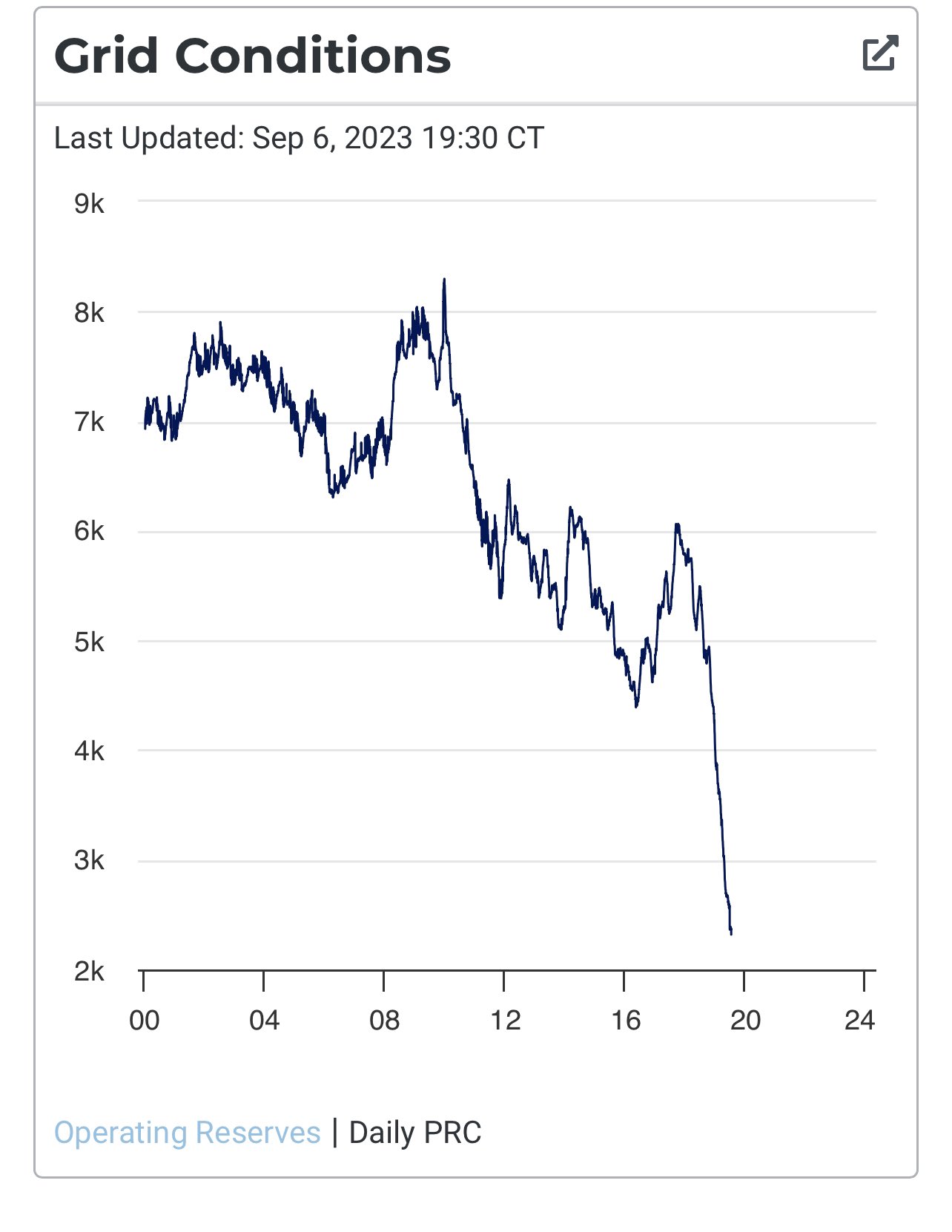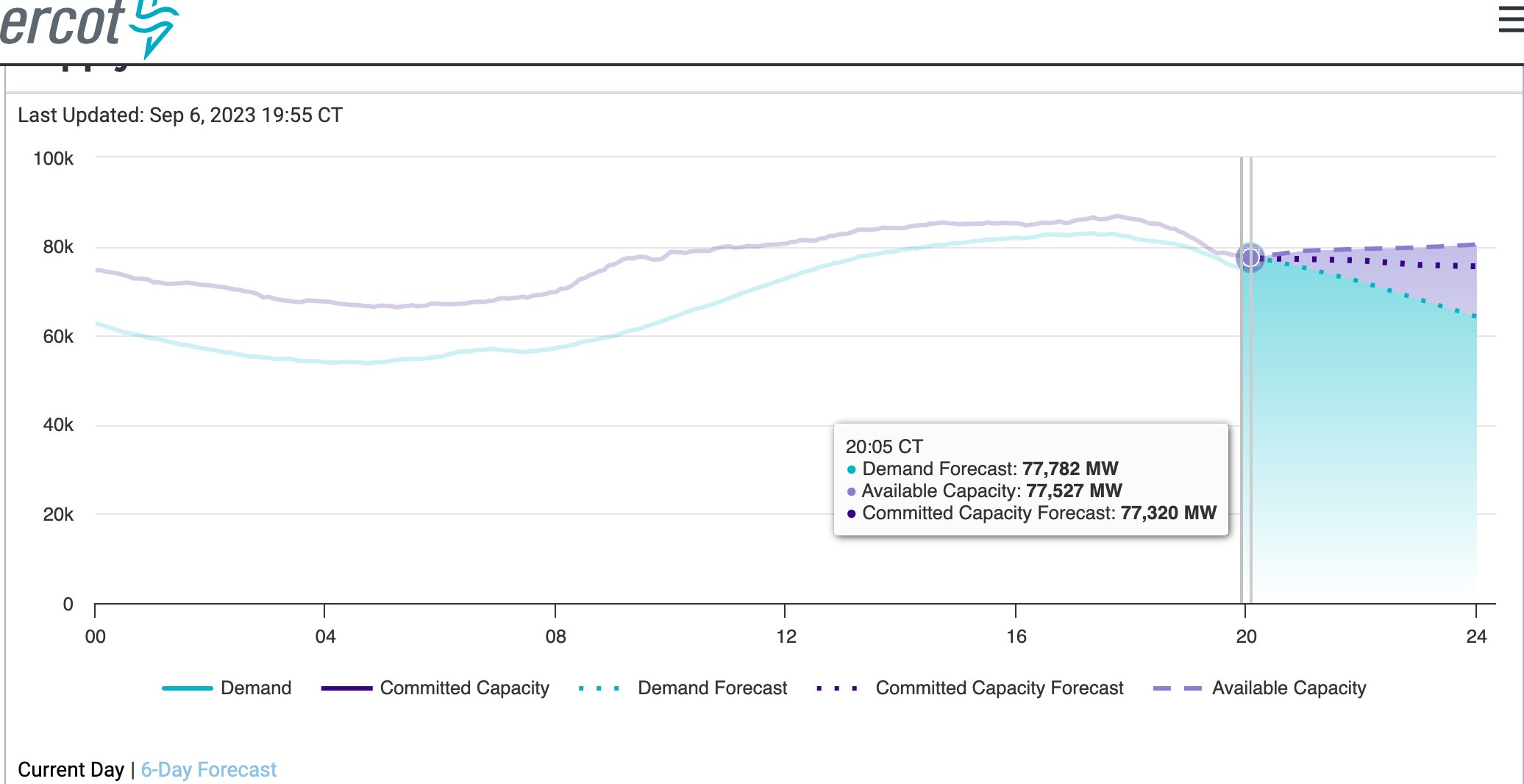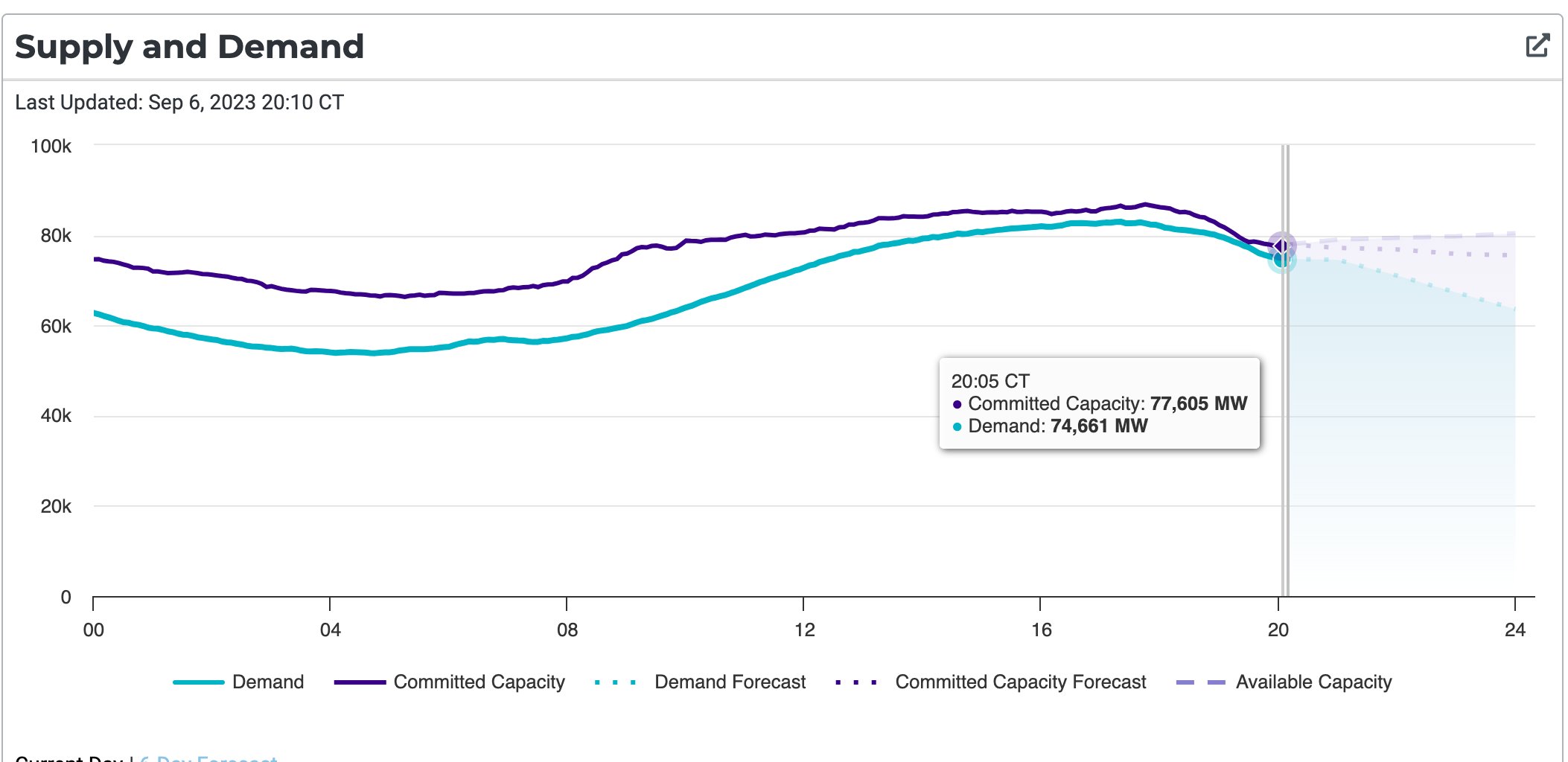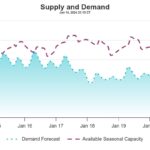The Electric Reliability Council of Texas (ERCOT) on Sept. 6 issued an Energy Emergency Alert 2 (EEA 2) after grid conditions quickly deteriorated around sunset (7:30 p.m.) as demand soared and operating power reserves plunged. The grid operator said that the emergency operations were necessary “due to a combination of dropping operating reserves and frequency.”
The EEA 2, ERCOT’s first declared Level 2 grid emergency since Winter Storm Uri in 2021, abruptly followed a conservation appeal that was issued at about 4:55 p.m. “Frequency of the entire ERCOT grid must be maintained between 60.1 Hz and 59.9 Hz at all times. By entering EEA 2, ERCOT was able to utilize additional reserve resources to protect the reliability of the grid,” it said. “No power outages associated with the ERCOT grid were necessary.”
While the grid operator exited emergency conditions at around 8:40 p.m., it retained its conservation appeal until 9 p.m. A Weather Watch remains in effect through Sept. 8, owing to higher temperatures that are driving high demand statewide.
Taking precautions, ERCOT on Thursday issued another conservation appeal for the evening of Sept. 7 from 5 p.m. to 9 p.m., urging all government agencies to implement programs to reduce energy use at their facilities.
The Public Utilities Commission of Texas (PUCT) on Thursday said that the grid operator is working with out-of-state independent system operators (ISOs) and market participants to obtain additional power generation capacity. ERCOT has also requested Texas Commission on Environmental Quality (TCEQ) enforcement discretion, “which allows a generator to extend its service/run-time/operations to help meet demand, if needed, and maintain grid reliability,” the PUCT said. In addition, ERCOT, acting cautiously, has requested a Federal Power Act section 202(c) Department of Energy order that could allow generating units within ERCOT to operate up to their maximum generation output levels as a response to generation shortages if necessary, the agency said.
A Steep Drop in Operating Reserves
An EEA declaration initiates an orderly and predetermined procedure for maximizing the use of available resources on the grid, including voluntary load reduction programs that are only available under EEA operations. An EEA 2 is typically issued when ERCOT’s operating reserves have dropped below 1,750 MW and are not expected to recover within 30 minutes. ERCOT’s EEA 2 declaration at sunset notably bypassed the grid operation’s declaration of an EEA 1, which is issued when ERCOT’s operating reserves fall below 2,300 MW. On Wednesday, ERCOT’s website suggested the grid had operating reserves of 2,388 MW when it declared the Level 2 alert.
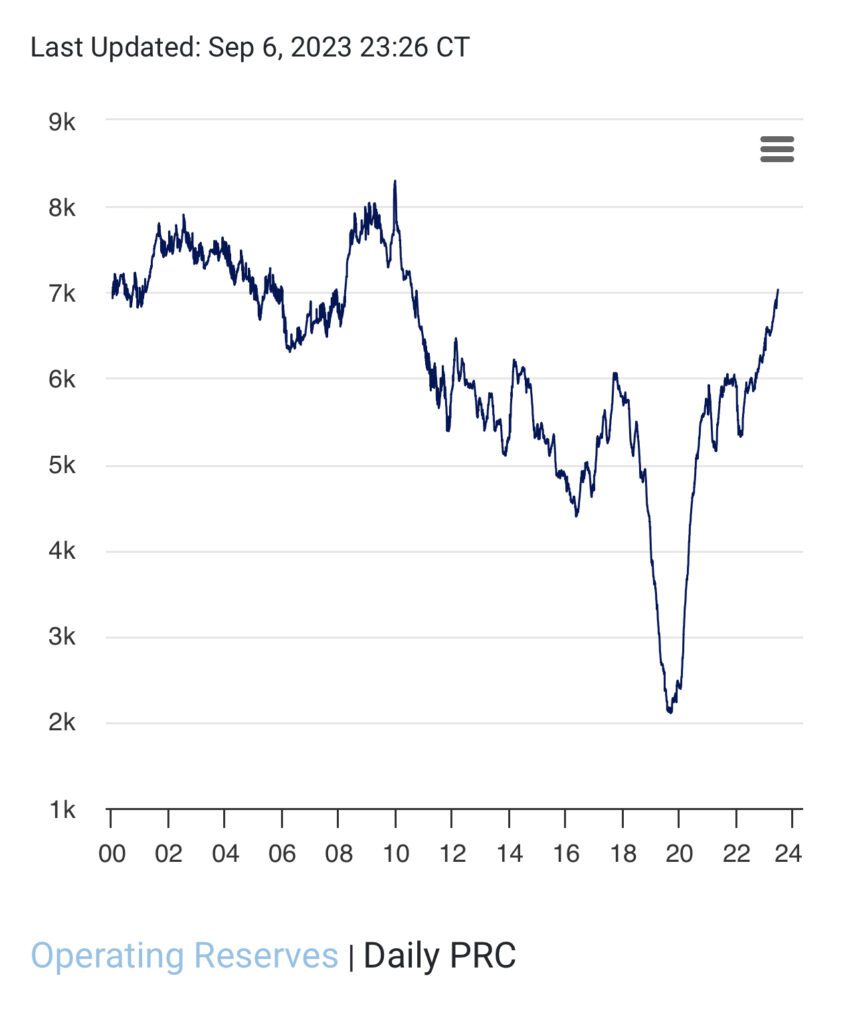
This snapshot of the dashboard shows ERCOT’s sharp reserve recovery in the hours following the EEA 2. Source: POWER
ERCOT’s dashboards illustrated its efforts to keep delicate grid conditions balanced during the emergency conditions. At around 8 p.m., its Supply and Demand dashboard forecasted precarious conditions in which available capacity barely exceeded its forecasted demand. At one point, the dashboard suggested demand would outweigh supply.
Top: A snapshot of ERCOT’s Supply and Demand dashboard on the evening of Sept. 6 shows that at one point (8:05 p.m.), demand was forecasted to exceed available capacity by 255 MW and committed capacity by 462 MW. Bottom: ERCOT’s data of how supply and demand actually panned out. Source: ERCOT
Pablo Vegas, ERCOT president and CEO, on Wednesday said the low reserves and frequency drop required direct entry into an EEA 2. “To protect the stability of the electric system, ERCOT has access to additional reserve sources only available during emergency conditions,” he noted.
Vegas said, “High demand, lower wind generation, and the declining solar generation during sunset led to lower operating reserves on the grid and eventually contributed to lower frequency, which precipitated the emergency level 2 declaration.”
Challenging Grid Conditions
Texas on Wednesday, notably, marked a peak record for September of 82,705 MW. “ERCOT set an all-time peak demand record of 85,435 MW on August 10,” the grid operator noted. By comparison, in 2022, the August peak demand was 78,465 MW. “This summer ERCOT has set 10 new all-time peak demand records,” it said. “Last summer ERCOT set 11 new peak demand records with a high of 80,148 MW on July 20.”
ERCOT has issued multiple “Weather Watch” alerts as Texas contends with one of its hottest summers on record. Parts of the state in August suffered up to 23 consecutive days of 100-degree heat. ERCOT has also issued multiple conservation appeals in recent weeks—more than in 2021 and 2022.
The grid operator, which manages the production and flow of electricity to more than 26 million Texas customers (about 90% of the state’s total power demand), has been transparent about its challenging grid conditions, which have required balancing soaring load growth with an evolving generation portfolio. Its challenges have intensified during periods of extreme heat or extreme cold.
In 2022, more than 7 GW of new wind and solar resources and 1.7 GW of energy storage resources entered the market. The grid operator’s May 3–released Seasonal Assessment of Resource Adequacy (SARA) for summer 2023, meanwhile, estimated total resources of 97 GW, including 10.4 GW of wind, and 12.6 GW of solar, and a typical thermal generating unit outage assumption of 5,034 MW.
As ERCOT released its summer SARA on May 4, however, ERCOT CEO Vegas and Peter Lake, former chairman of the Public Utility Commission of Texas (PUCT), sought to lay out in stark terms what they described as the state grid’s “new reality.” They suggested the increase in demand for electricity has outpaced the supply of on-demand power from power plants that can be turned on and off according to market needs. “On the hottest days of summer, there is no longer enough on-demand dispatchable power generation to meet demand on the ERCOT system,” Lake said. The grid’s “risk goes up as the sun goes down because it’s still hot at 9 p.m.,” he added.
In June, ERCOT unveiled an internal model that suggests the likelihood of an EEA is especially elevated between 8 p.m. and 9 p.m., particularly when the capacity for operating reserves is less than 3 GW. The model also suggests that the grid’s profile for load shed risk dramatically ramps up after 7 p.m., when the sun sets and its solar generation diminishes.
Resource Adequacy: An Underlying Gap
On Wednesday, at 7:30 p.m.—as ERCOT abruptly declared its EEA 2—the grid had begun ramping up its natural gas power and power storage supply, but it suffered a steep decline in operating reserves.
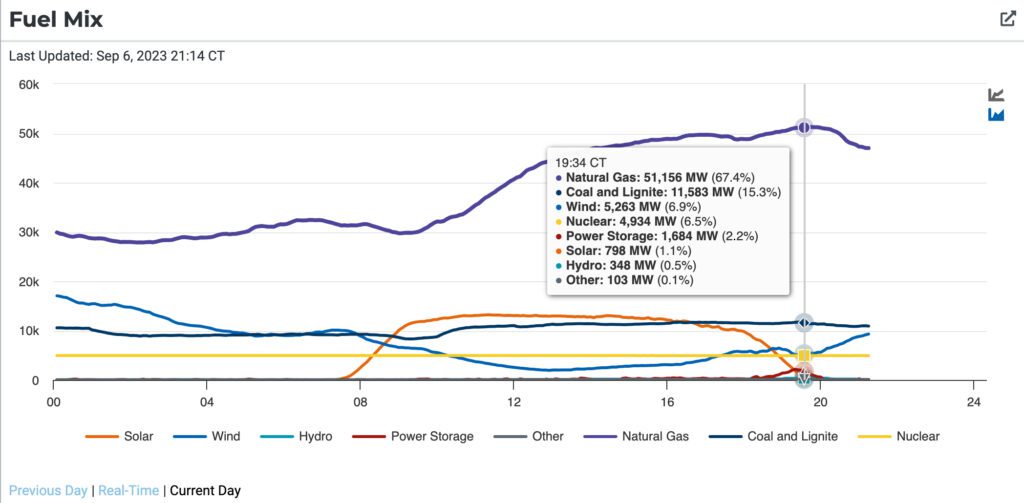
ERCOT will likely issue more details about the incident in the coming days. Some industry observers have speculated that the decline may have resulted from an unscheduled power plant outage.
ERCOT declared an energy emergency. This was *likely* a big power plant tripping off line; see the frequency drop below. Storage set an all-time record when it was needed most, almost certainly preventing rolling outages. #txlege #txenergy #energytwitter pic.twitter.com/rd5k9OqjSR
— Doug Lewin (@douglewinenergy) September 7, 2023
However, the Texas Competitive Power Advocates (TCPA), a trade association representing power generators in the ERCOT wholesale and retail electric markets, pushed back against speculation that the frequency drop was precipitated by a “big plant trip.”
There was no “big plant trip” last night. @ERCOT_ISO reports each night if that occurs. Some want #txlege & #energytwitter to believe every tight condition is caused by thermal. Focusing on reliability & not a personal agenda would better serve Texas. pic.twitter.com/m7EZsIKWIi
— TCPA (@TXCompPower) September 7, 2023
Still, the “reality is ERCOT has run the existing thermal fleet exceptionally hard for an extended period of extreme heat to meet Texans’ needs,” since the beginning of June, Michele Richmond, TCPA executive director, told POWER on Thursday. So far, the outcome has been good, owing to diligent maintenance. “[C]ompanies have been maintaining their fleets, taking small outages to make repairs or adjustments when demand was expected to be lower or at times that other resources were expected to be available. This has been part of the effort to run as efficiently as possible and to be available to meet the record-breaking demand during an extended period of extreme heat, even by Texas standards,” she said.
However, looking ahead, generators will need to prime their fleets for future high-demand seasons, Richmond acknowledged. “These resources will need to take time in the fall to perform required maintenance necessary to ensure they are ready to perform for the upcoming winter,” she added. She also raised concerns about federal emissions rules, noting that “resources that have been run at a near-constant rate [are beginning] to reach their federal limits.”
The underlying gap affecting the grid’s reliability today, Richmond said, relates to resource adequacy—the adequate supply of electric generation to meet demand and maintain capacity reserves to help support grid reliability. “This summer shows the importance of resource adequacy as last night’s event and the many conservation alerts spotlight the lack of adequate resources in ERCOT. Overall, the importance of a market that provides a path for investment in new resources while sustaining existing resources is being highlighted by these tight conditions,” she said.
Texas Legislature has already delegated that task to the PUCT and ERCOT, Richmond noted, and both are “currently working” on it. “Confidence in a sustainable ERCOT market will yield investment in the desired new dispatchable resources, but new power plants do not appear overnight,” she said.
—Sonal Patel is a POWER senior associate editor (@sonalcpatel, @POWERmagazine).
Editor’s note: This story has been substantially updated since its original publication on Sept. 6


